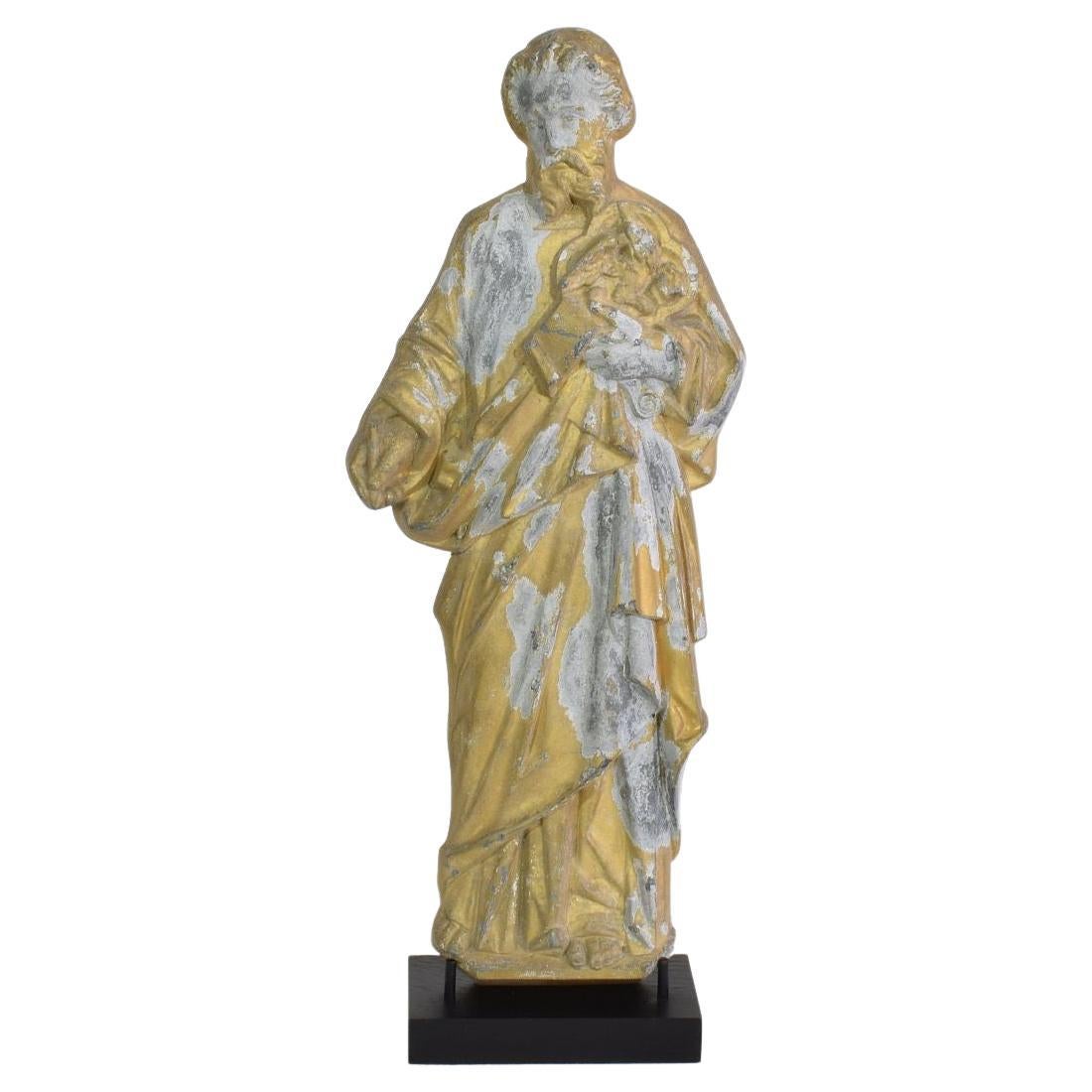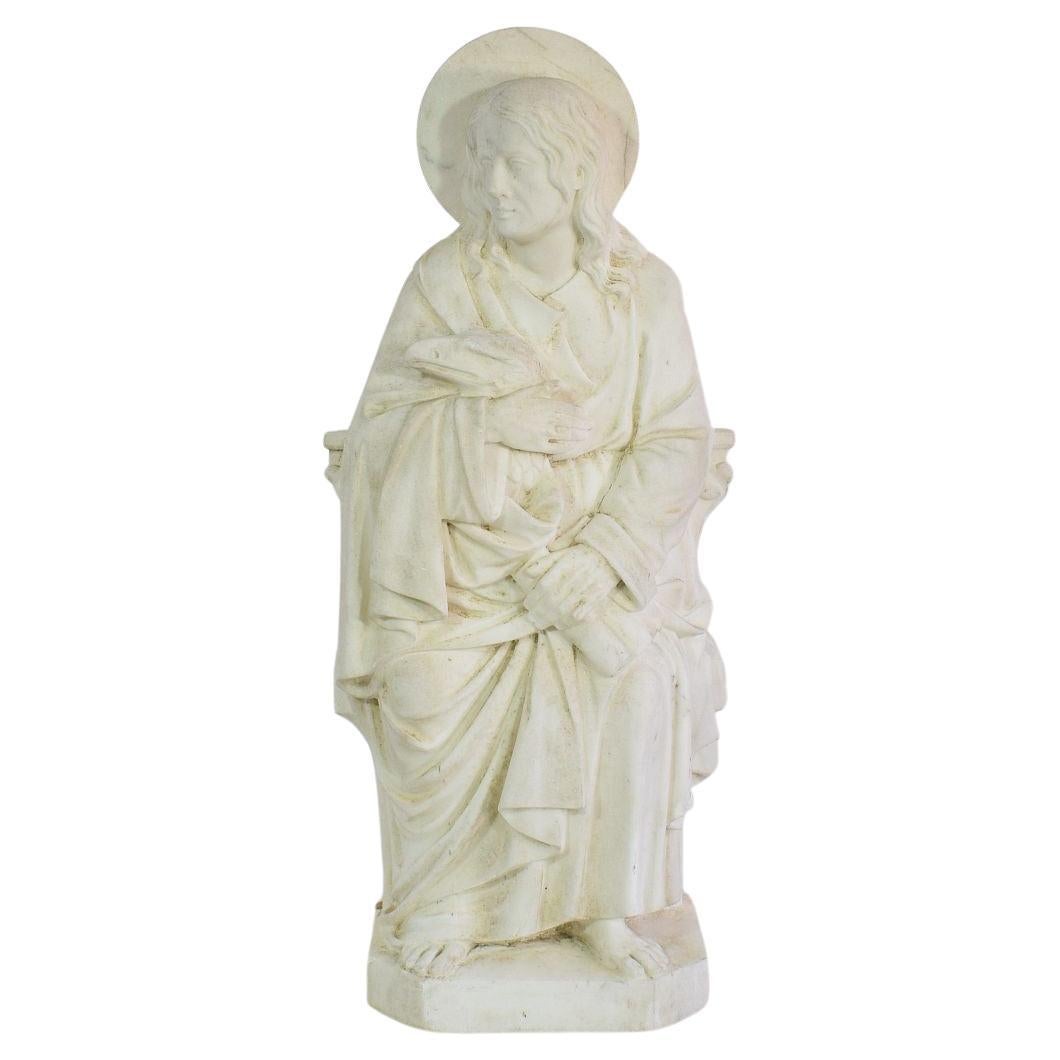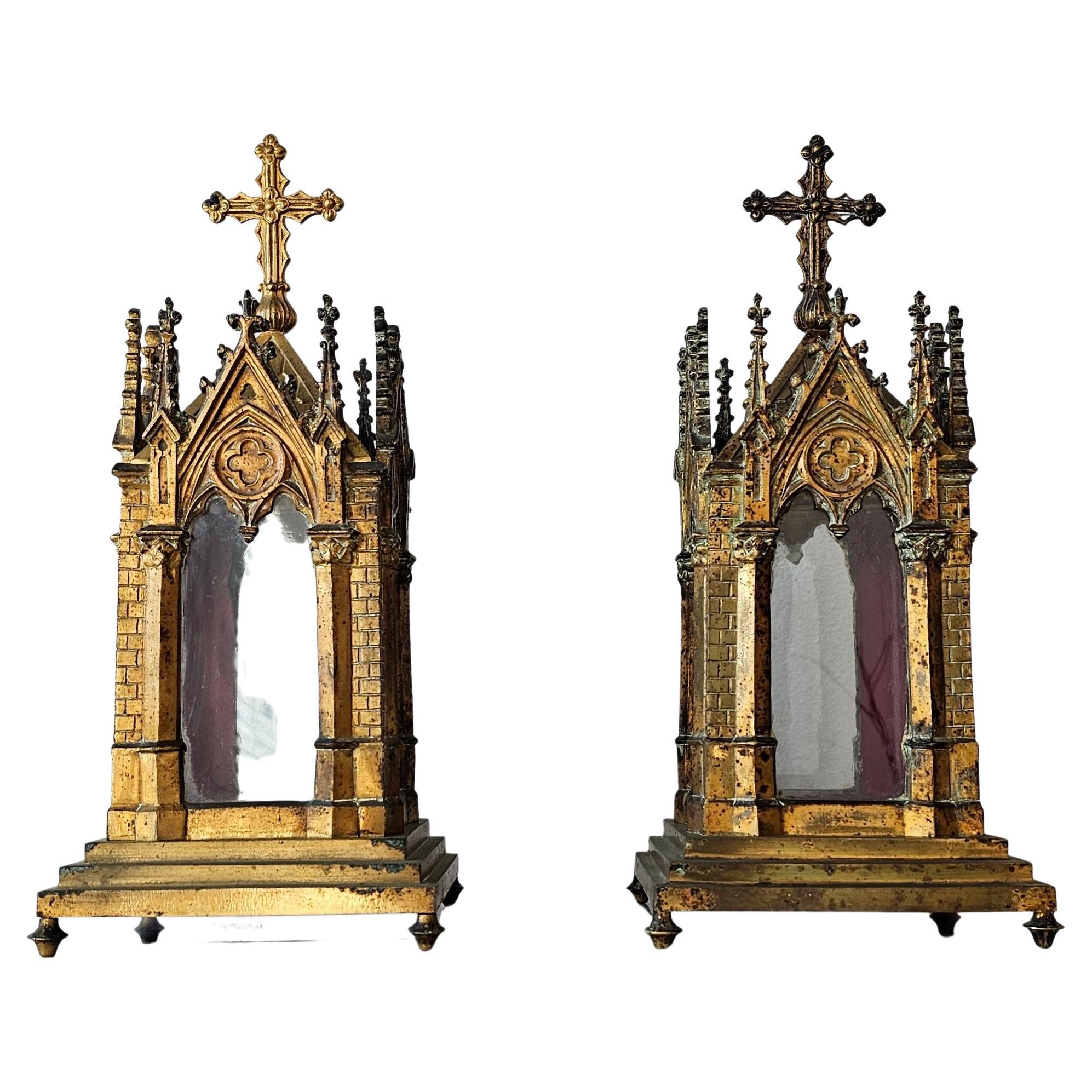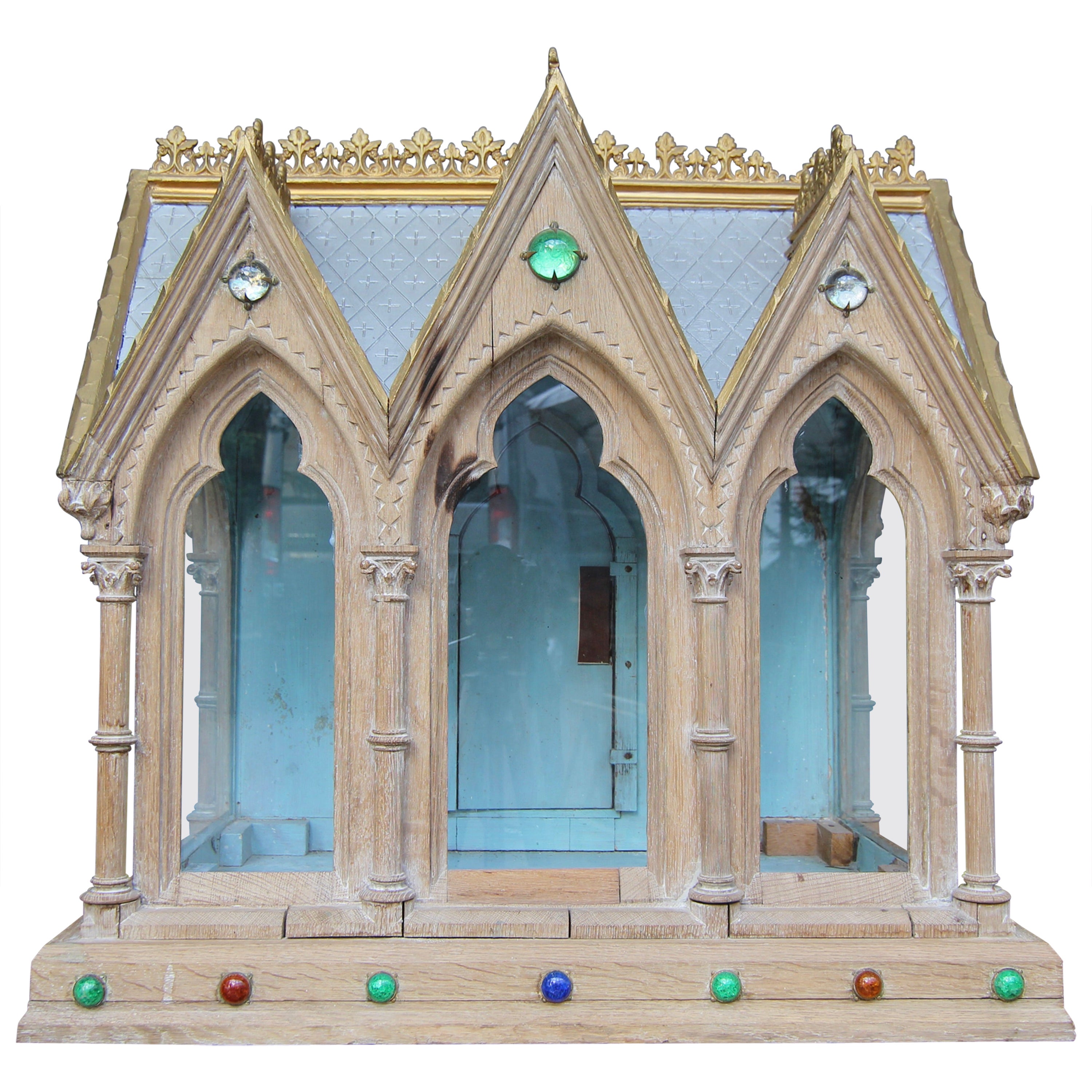Items Similar to French Late 19th Century Neo Gothic Gilded Metal Saint Statue
Want more images or videos?
Request additional images or videos from the seller
1 of 15
French Late 19th Century Neo Gothic Gilded Metal Saint Statue
About the Item
Wonderful gilded metal saint statue with beautiful expression,
France, circa 1880-1900.
Weathered. Measurements include the wooden base.
- Dimensions:Height: 14.18 in (36 cm)Width: 5.12 in (13 cm)Depth: 2.76 in (7 cm)
- Style:Gothic Revival (Of the Period)
- Materials and Techniques:
- Place of Origin:
- Period:
- Date of Manufacture:circa 1880-1900
- Condition:Wear consistent with age and use.
- Seller Location:Buisson, FR
- Reference Number:
About the Seller
5.0
Platinum Seller
These expertly vetted sellers are 1stDibs' most experienced sellers and are rated highest by our customers.
Established in 2013
1stDibs seller since 2017
1,106 sales on 1stDibs
Typical response time: 2 hours
- ShippingRetrieving quote...Ships From: Buisson, France
- Return PolicyA return for this item may be initiated within 3 days of delivery.
More From This SellerView All
- French Late 19th Century Neo Gothic Gilded Metal Saint StatueLocated in Buisson, FRWonderful gilded metal saint statue with beautiful expression. France, circa 1880-1900. Weathered. Measurements include the wooden base.Category
Antique Late 19th Century French Gothic Revival Figurative Sculptures
MaterialsMetal
- 19th Century French White Marble Statue Of Saint JohnLocated in Buisson, FRBeautiful weathered white marble statue representing Saint John the Evangelist. Christian tradition says that John the Evangelist was John t...Category
Antique 19th Century French Gothic Revival Figurative Sculptures
MaterialsMarble
- 18th 19th Century French Carved Oak Panel of Saint PhilomenaLocated in Buisson, FRBeautiful weathered oak panel representing Saint Philomena. Also known as Philomena of Rome was a young virgin martyr whose remains were discovered ...Category
Antique 18th Century French Baroque Figurative Sculptures
MaterialsOak
- Italian 19th Century Carved Wooden Saint FigureLocated in Buisson, FRVery nice saint figure. Hand carved wood with glass eyes Italy, circa 1800-1850. Weathered, small losses.Category
Antique 19th Century Italian Baroque Figurative Sculptures
MaterialsWood
- Large French 19th Century Hand Carved Wooden Fragment of a MarionetteLocated in Buisson, FRVery nice handcarved fragment of a marionette. France, circa 1850. Weathered, small losses and old repairs Measurement include the wooden base.Category
Antique 19th Century French Folk Art Mounted Objects
MaterialsTextile, Wood
- French, 18th Century, Baroque Gilded Metal Procession CrossLocated in Buisson, FRBeautiful baroque gilded metal procession cross with a great patina. France circa 1750. weathered and small losses. Measurements include the wooden pedestal.Category
Antique 18th Century French Baroque Religious Items
MaterialsIron
You May Also Like
- Fine 19th Century French Neo-Gothic Gilt Metal Cathedral Church Reliquary PairLocated in Forney, TXA stunning pair of very fine quality French Neo-Gothic gilt metal church reliquaries. circa 1860s Most impressive objets d’art, born in France in the second half of the 19th century, most likely Parisian gilded bronze and brass ormolu work, exceptionally executed sculptural form, the exquisitely detailed architectural cathedral shaped case having a removable pointed steeple roof with cross finial, opening to relic display case surrounded on all sides by original glazed glass panes, stepped base, rising on disc feet. Signed, stamped by maker / bronzier "BC" (unknown) model "5096" and other faint marks to lid interiors. Additional photos available upon request Dimensions: (approx) 14.75" High, 6.75" Wide, 6.75" Deep; 13.25 lbs total History: A reliquary (also referred to as a shrine, by the French term châsse or monstrance) is a container for important religious relics. The earliest reliquaries were essentially boxes, either simply box-shaped or based on an architectural design, taking the form of a model of a church with a pitched roof. These latter are known by the French term chasse, and typical examples from the 12th to 14th century have wooden frameworks with gilt-copper plaques nailed on, decorated in champlevé enamel. Limoges was the largest production centre; NB the English usage differs from that of the French châsse, which denotes large size rather than shape. Relics of the True Cross became very popular from the 9th century onward and were housed in magnificent gold and silver cross-shaped reliquaries decorated with enamels and precious stones. From about the end of the 10th century, reliquaries in the shape of the relics they housed also became popular; hence, for instance, the skull of Pope Alexander I was housed in a head-shaped reliquary. Similarly, the bones of saints were often housed in reliquaries that recalled the shape of the original body part, such as an arm or a foot. A philatory is a transparent reliquary designed to contain and exhibit the bones and relics of saints. This style of reliquary has a viewing portal to view the relic inside. The feretrum was a medieval form of reliquary or shrine containing the sacred effigies and relics of a saint. During the later Middle Ages, the monstrance form, primarily used for consecrated hosts, was sometimes used for reliquaries. These housed the relic in a rock crystal, or glass capsule mounted on a column above a base, enabling the relic to be displayed to the faithful. Reliquaries in the form of large pieces of metalwork jewellery also appeared around this time, housing tiny relics such as pieces of the Holy Thorn, notably the Holy Thorn Reliquary now in the British Museum. Condition: Superb museum quality examples, in excellent original unrestored antique condition with beautifully aged patina. Wear consistent with age and use. Heavily patinated - scattered oxidation. Overall wonderful examples. Typically reliquaries were not sold in pairs, so to find a matching pair such as this is exceptionally rare. Worldwide shipping available Local pickup available near Dallas, Texas Additional: We here at Lynx Hollow Antiques love religious antiques, from Christian tabernacles, Catholic altarpiece, life-size Buddhist temple sculptures, Hindu votive offerings, 16th century Islamic mosque architectural salvaged windows...Category
Antique Mid-19th Century French Gothic Revival Religious Items
MaterialsBrass, Bronze
- Late 19th Century Gothic Revival Reliquary CasketLocated in Dusseldorf, DEA Gothic Revival reliquary. Circa late 19th / early 20th century. Made of solid oak with fine carving. Reliquaries have been used to store relics since the Middle Ages. In sacred architecture they are often located behind the main altar in the chancel. In addition to classical, often church-like caskets, anthropomorphic, so-called "speaking" reliquaries were also made, which already inform the viewer about their contents through their own design. Mostly they were made of precious metals and decorated with rich sculptural ornaments or precious stones. One of the most famous examples of reliquaries is the Epiphany shrine of Nicholas of Verdun from the late 12th or early 13th century in Cologne Cathedral. The reliquary offered here has an architectural structure with a rectangular ground plan. The three-sided glazed box with a dormer roof rests on a plinth. A total of 8 columns of Corinthian order form the arcades which are crowned on both long sides by 3 lancets each and enclose the lancet windows...Category
Antique Late 19th Century German Gothic Revival Religious Items
MaterialsGlass, Oak
- Neo-Gothic 19th Century Octagonal Pedestal / Stand / Architectural ModelLocated in Troy, NYAn unusual pedestal of octagonal Neo-Gothic form, the molded base supporting eight shaped and carved columns decorated with typical Gothic designs, topped by eight spikes surrounding...Category
Antique Mid-19th Century English Gothic Revival Pedestals
MaterialsOak
- 19th Century French Gothic Sacrament CabinetLocated in Dallas, TX19th Century French Gothic Sacrament cabinet was artfully sculpted from solid oak and fruitwood to create a remarkable religious artifact designed to be appreciated throughout the ages! The trapezoidal form of the casework is in keeping with the Gothic style, which historians concur originated in the Cathedral of St. Denis during the middle of the 12th century. Boldly molded crown follows the complex contours and overlooks the case below which features a single door flanked by cornerposts that feature pilasters facing front as well as the sides, with recessed arched panels topped with recessed circular frames above filled with carved rosettes highlighted in gold. The arched recesses facing the front are also filled with carved floral and wheat motifs also highlighted in gold, representing the Bread of Life. The door panel, however, steals the show, with a gloriously carved relief work depicting both wheat and fully laden grapevines adding the significance of the Blood of Christ...Category
Antique Mid-19th Century French Gothic Revival Religious Items
MaterialsFruitwood, Oak
- Angel or Archangel, Metal, 19th CenturyLocated in Madrid, ESAngel. Metal in silver finish. XIX century. Angel or archangel figure made of silver metal, and standing on a base that resembles clouds. These types of sculptures were common in t...Category
Antique 19th Century European Neoclassical Revival Religious Items
MaterialsMetal, Other
- 19th Century Statue of St JeromeLocated in Mjöhult, SEEarly 19th century wooden statue of St Jerome, circa 1800. South Europe.Category
Antique Early 1800s Italian Baroque Figurative Sculptures
MaterialsWood
Recently Viewed
View AllMore Ways To Browse
19th Century French Gothic Furniture
Gothic Gilt
Gothic Metal
Gilded Saint
Neo Gothic
Neo Gothic Furniture
French Neo Gothic
Gothic Saint
Neo Gothic Revival
Religious Statues
Gothic Gilded
Wooden Religious Statue
Antique Wooden Religious Statues
Wooden Saint Statue
Church Window Antique
Antique Church Windows
Crucifixes Wall
Religious Altar





